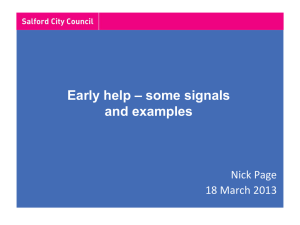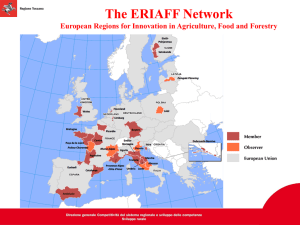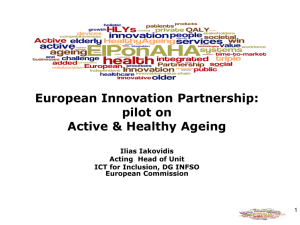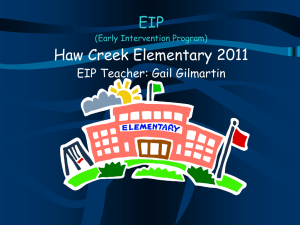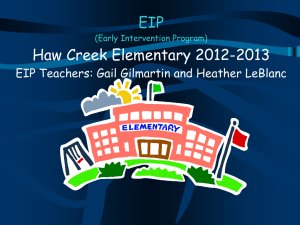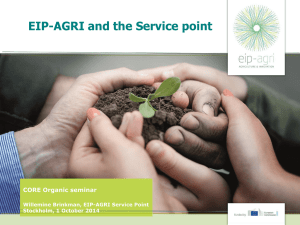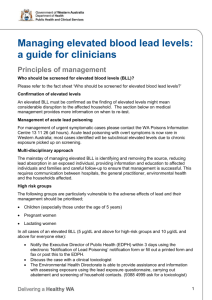Presentation 1 - National Healthy Homes Conference
advertisement
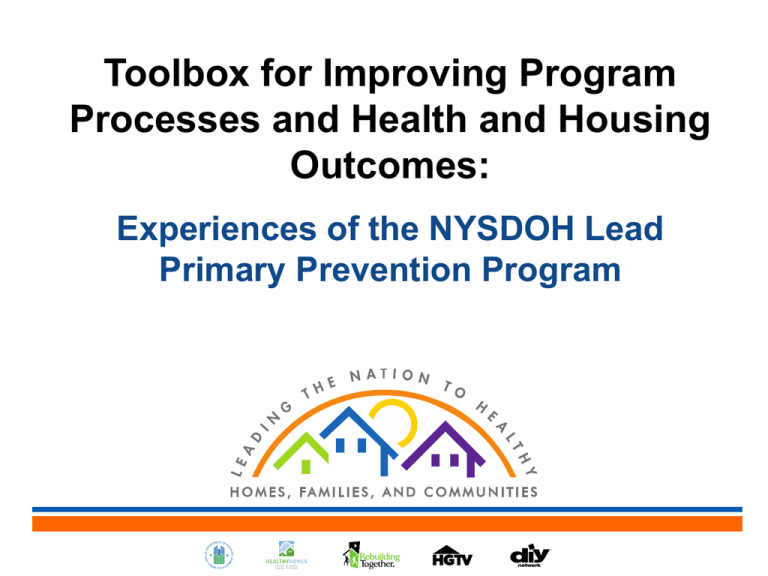
Toolbox for Improving Program Processes and Health and Housing Outcomes: Experiences of the NYSDOH Lead Primary Prevention Program Panelists Moderator: Amy Murphy, MPH, Consultant & TA Provider to the NCHH & NYSDOH Panelists: • Cathe Bullwinkle, Oneida County Health Department • Debra Lewis, Onondaga County Health Department Prevalence of Childhood Lead Poisoning New York State 4.8% United States 2.6% NY State CLPPP 8 original pilot locations funded in 2007 15 grantees operating through 2013 Year Funding Amount 2007-2008 $3 million 2008-2009 $5 million 2009-2010 $7.7 million 2010-2011 2012-2013 $10 million Childhood Lead Poisoning Prevention Program – CLPPP FIVE GOALS Identify high risk housing Develop partnerships and engage the community Promote LHC interventions Build lead-safe work practice capacity Identify& leverage community resources 15 Target Counties NCHH • Provides technical & evaluation assistance • Grantees required to conduct cost analysis and/or outcomes evaluation Technical Assistance Briefs • Cost Analysis Templates & Guidelines • Effectiveness of targeting high risk blocks • Post-remediation follow-up • Projecting the burden of exposure in areas with low screening rates Approaches to Cost Analysis •Cost of Illness: Economic burden of a disease •Cost Analysis: Value of the resources required to implement an intervention •Cost-Effectiveness Analysis: Costs saved because an adverse health condition was prevented •Cost-Benefit Analysis: Net benefit determined by subtracting the monetary benefit (averted adverse health or environmental outcomes) from the cost of the intervention Cost Analysis • Health Care Expenditures • Special Education • Juvenile Delinquency • Early Intervention Program • Cost of Program Services • Benefit of Window Replacement • IQ & Lifetime Earnings Loss • Return on investment Cost of Illness Magnitude of a public health problem in monetary terms Medical, nonmedical, social and educational costs Potential savings associated with an implementing an intervention Health Care & Public Costs • Direct health care costs of lead poisoning: – – – – Screening Medical Management Nursing Case Management Environmental Services • 2006 Consumer Price Index • Conservative estimates • Includes only direct medical costs for children Cost of Illness Estimates Blood Lead Level Number of Children 10-15µg/dL 250 Estimated Health care cost per child $74 Cost Incurred 15-20µg/dL 150 $74 $11,100 20-45µg/dL 95 $1,207 $114,665 45-70µg/dL 5 $1,335 $6,675 >70µg/dL 0 $3,444 0 $18,500 500 children Total Costs $150,949 Special Education Expenditures • Impaired neurobehavioral function • 20% of children with blood lead levels >25 µg/dL will need special education. • School districts have average annual cost of special education • Standard Education: $8,322 Special Education: $14,317 Differential: $5,995 • • Three years of special education needed on average Juvenile Delinquency • Estimated that 10% of juvenile delinquency may be attributed to lead poisoning. • $34,000 per year to incarcerating youth. IQ & Lifetime Earnings Loss Basic Formula IQ loss within BLL group X Earnings loss per IQ point X Number of children/ category = Net lifetime earnings loss Mathematical formula for the 2-10 µg/dL group 1. Average Rate of IQ Loss per µg/dL within BLL Group X Total IQ Points Lost within BLL Group 5 x .513 = 2.565 2. Lifetime Earning Loss X Total IQ Points Lost = Loss per child $18,948 X 2.565 = $48,627 3. Applied to the number of children within BLL Group (60) Lifetime earning loss x Number of children 60 X $48,627 $2,917,636 IQ and Lifetime Earnings Loss Blood lead level Number of Children (Prevalence) Average Blood Lead Level Average Rate of IQ Loss per µg/dL within BLL Group Total IQ Points Lost within BLL Group Lifetime Earning Loss within BLL Group ($18,958, x Total IQ Points Lost) Applied to the number of children within BLL Group 2-10 µg/dL 60 5 .513 2.565 $48,627 (Lifetime earning loss x number of children) $2,917,636 10-20 µg/dL 40 15 .19 6.08 $115,265 $4,610,586 >20 µg/dL 10 20 .11 7.03 $133,275 $1,332,747 110 Net lifetime earnings loss $8,860,969 Costs of Lead Exposure in NYS Cost of Illness - Childhood Lead Exposure New York State -2010 (including NY City) • Cost of illness estimates 2010 • Impact of lead exposure on health care expenditures, special education, and lifetime earnings loss • NYC: $1,555,637,637 (62%) Impact Total Cost Health Care $3,281,942 Special Education $1,260,883 IQ and Lifetime Earnings Loss $2,514,923,250 Total $2,519,466,075 Early Intervention • Identify children served by EIP • Eliminate those served due to other issues • De-identify eligible children • Extract & organize EIP service data • Link EIP services to costs Oneida County Costs of Child Find & Early Intervention Newly Diagnosed Children with EBL > 15 ug/dL • Refer all children < 3 at risk for developmental disabilities • Screening - Ages & Stages Questionnaire • 186 children 2009-2010 – 5.3% of all new admissions to CF & EIP Calculating EIP Costs 1) Identify children with lead exposure being served by EIP. 1) Determine if children are being served by EIP because of lead exposure 2) De-identify the children by assigning a unique child ID. 3) Extract and obtain information on EIP services received and enter into an Excel spreadsheet. 1) Date of enrollment 2) Length of enrollment 3) Service type: Speech Language Pathology (SLP), Occupational Therapy (OT), Physical Therapy (PT), Special Instruction Teacher/Special Education services, Other Services 4) Determine costs for EIP Services (In Oneida County, the cost per unit is the same for all services) 4) Calculate the value of third party reimbursement for services (if available) 5) Calculate the cost of EIP services per year and per child. Early Intervention Program • Evaluation to assess & monitor needs – $59.43 per child • Costs of Services: $134,414 (2009-10) – $4,596 Average Total Cost of EIP/Child – $2,143 Average Net Costs after Reimbursement/Child Services Provide/Cost Analysis Services Physical Therapy Occupational Therapy Speech Therapy Cost Breakdown 77% 16% 7% Additional Efforts • Cost of Illness Estimates 2009-11 • Prevalence Decreases in Target Areas – Quantify the impact of program efforts over time Onondaga Compare EIP Costs: • Children identified with EBL > 5 ug/dL before EIP enrollment • Children identified with EBL > 5 ug/dL after EIP enrollment • Children receiving EIP services who did not have an EBL Methodology • Obtain EIP intake logs for 2009 < 36 months of age • Match with LeadWeb Surveillance Data for children • Extra EIP Child Service Reports of eligible children • Calculate Costs of EIP services for each category EIP Cost Comparison Category Number of Children Average Cost Total Cost One BLL > 5ug/dL prior to EIP 67 $2,994 $200,580 One BLL >5 ug/dL after EIP enrollment 88 $4,610 $405,664 No BLL but tested prior to EIP 142 $5,604 $795,765 No BLL and not tested prior to EIP 73 $9,115 $664,606 Discussion of Findings • Children without an EBL referred at an earlier age due to more severe delays and greater need for services? • Would the findings have been different if used a threshold of 15 ug/dL? • Need to control for age? Referral source? • Look at multi-year service data? LEAN QI Process Goal: To study the enforcement process Process Elements: • Process mapping • Visioning • Time studies • Policy review • Inclusion of staff at all levels Issues of Concern • • • • Gaining access/contacting tenants Multiple field visits Clerical task duplication Inefficient management of electronic documents • Long compliance time frames • Hearing schedule backlog Policy & Procedure Changes • Updated tenant screening form • Integration of enforcement efforts – – Combine hearing notice, order posting, reinspections • Notice & Information eliminated • Policy on vacant properties • Electronic case files and folders Additional Efforts • IQ & Lifetime Earnings Loss Costs of Program Services 1. Document protocols or procedures 5. Average time across staff 2. Specify staff roles 6. Identify hourly rates 3. Develop time estimating worksheets 7. Calculate intervention costs 4. Document time for each step over a period of time 8. Determine indirect costs 9. Link to program outputs/activities Risk Assessment Costs by Type Includes program activities from the time a housing unit is referred into the program thru dust wipe clearance. Risk Assessment - No hazards identified: Risk Assessment - Hazards identified: Risk Assessment – Enforcement: $235.17 $1,088.70 $1,366.22.* Analysis: •When enforcement is needed the costs to the program increases, at a minimum, by $277.52. •This cost is incurred per hearing date. •Some cases have multiple hearing dates due to chronic noncompliance. Monetary Benefit of Window Replacement • Formula: Market Value Benefit + Health Benefit – Lead Hazard Control Costs = Net Benefits (CBA) Varies by housing size, # of windows replaced and age of housing. • Energy Star Window Savings: – 15-24% reduction in energy bills – $20 for every dollar per year in energy savings • Increase in Property Values: – $100 per window – 95% costs of paint stabilization • Health benefits: • • • $6,847 Pre-1940 Housing $2,847 1940-1959 Housing $632 1960-1977 Housing Data Required Risk assessment costs Window replacement costs Paint stabilization costs Cleanup and lead dust clearance costs Number of windows replaced Annual energy bill pre-lead hazard control Monetary Benefit of Window Replacement Window Replacement 800 ft2 Attached 7 Windows $6,118 1200 ft2 Detached 10 Windows $9,684 1800 ft2 Detached 16 Windows $15,494 Weighted Average Interior Paint Stabilization $146 $146 $146 Weighted Average Exterior Paint Stabilization $291 $291 $291 Specialized Cleanup $386 $510 $510 Lead Dust Clearance Testing $175 $219 $219 Average Cost $7,116 $10,850 $16,660 Annual Energy Savings (15%-25%) $130-216 / yr $194-324 / yr $292-486 / yr Windows $5,485 $8,681 $13,890 Weighted Average Interior Paint Stabilization $144 $144 $144 Weighted Average Exterior Paint Stabilization $270 $270 $270 Average Market Value Benefit $5,899 $9,095 $14,304 Weighted Average in Pre-1940 Housing $6,847 $6,847 $6,847 Weighted Average in 1940–1959 Housing $2,847 $2,847 $2,847 Weighted Average in 1960–1977 Housing $632 $632 $632 Costs Market Value Benefits Average Lead Hazard Reduction Benefit Formula Costs: Window Replacement: Actual Installed Cost $ Paint Stabilization: Actual Cost $ Cleanup and Lead Dust Clearance Testing: Actual Cost $ Total Cost = A $ Sum of all homes Market Value Benefits: Windows Market Benefit = $100/window + (20% of the previous year annual energy bill) x 20) $ Paint Stabilization Market Benefit = 95% of Actual Cost $ Total Market Value Benefit = B $ Sum of all homes Lead Hazard Reduction Benefits Pre-1940 units multiplied by $6,847 $ 1940-1959 units multiplied by $2,847 $ 1960-1977 units multiplied by times $632 $ Applicable Lead Hazard Reduction Benefit = C Net Benefits: B + C - A $Sum of all homes $ Projecting Prevalence Step 1. Are the demographics of children screened the same as the general population of children? Prevalence rate X Number of children < 6 Step 2. If not representative…. Determine prevalence rates by race Multiply by the number of children of that racial/ethnic origin Add the projections to determine the burden of lead exposure Effectiveness of Targeting High Risk Blocks Questions: Is there a neighborhood effect? Efficacy of canvassing and focusing on exterior lead hazard control. • Identify comparable geographic areas • Document baseline prevalence • Determine postintervention burden of lead exposure Post-remediation Follow-up • How long to housing units remain lead safe? • What is the level of maintenance after LHC and how important is it? • What is the contribution of dust lead tracked in from outside sources? • What is the value of a lead safe housing registry? • How realistic are community-wide remediation targets? Post-remediation Follow-up Analysis • Number & extent of LBP hazards at each interval. • What rooms or components have a higher likelihood of reoccurring hazards? • How long do housing units remain lead-safe? • Where are dust lead levels the highest post remediation? • Variance based on who conducted the work? Considerations • Change in inspectional/risk assessment protocols? • Change in interventions standards? • Change in who can conduct work? • Systems requiring maintenance? • Communicate results to owners. Post-remediation Follow-up Options • Comparison of baseline & post-remediation paint condition. • Examination of post-remediation paint condition & dust levels. • Comparison of baseline & post-remediation paint condition & dust levels. Return on Investment Controlling lead hazards For every dollar spent on LHC, $17-$221 returned in health benefits, increased IQ, higher lifetime earnings, tax revenue, reduced spending on special education and reduced criminal activity Vaccination Returns $5.30 - $16.50 for every dollar invested in immunizations References • Gould E. 2009. Childhood Lead Poisoning: Conservative Estimates of the Social and Economic Benefits of Lead Hazard Control. Environmental Health Perspectives. 117(7): 1162-1167. Uses IQ point loss value of $17,815 from Schwartz, et al (1994) based on 2006 USD. • Korfmacher KS. 2003. Long-Term Costs of Lead Poisoning: How Much Can New York Save by Stopping Lead? Working Paper: Environmental Health Sciences Center, University of Rochester, 9 July 2003. Available: http://www.sehn.org/tccpdf/lead%20costs%20NY.pdf [accessed 10 October 2008]. • Lanphear BP, Hornung R, Khoury J, Yolton K, Baghurst P, Bellinger DC, et al. 2005. Low-Level Environmental Lead Exposure and Children’s Intellectual Function: An International Pooled Analysis. Environmental Health Perspectives. 113:894-899. • Nevin R, Jacobs D, Berg M, Cohen J. 2008. Monetary Benefits of Preventing Childhood Lead Poisoning with Lead-Safe Window Replacement. Environmental Research. 106: 410-419. • Oklahoma Department of Health. September 2010. Economic Impact of Childhood Lead Poisoning. The Bulletin. pp 40-43. Uses IQ point loss value of $18,958 based on 2009 USD (adjusted for inflation). • Zhou F, Santoli J, Messonnier ML, Yusuf HR, Shefer A, Chu SY. 2005. Economic Evaluation of the 7Vaccine Routine Childhood Immunization Schedule in the United States, 2001. Archives of Pediatrics & Adolescent Medicine 159:1136–1144. Questions?
